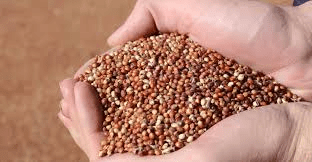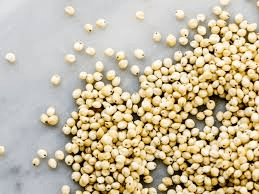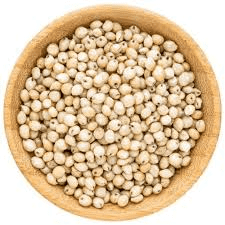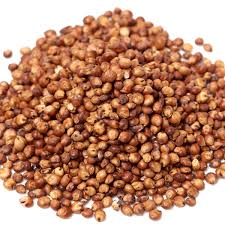Guinea corn seeds, commonly known as sorghum (Sorghum bicolor), are a staple grain that plays a crucial role in global agriculture, particularly in arid and semi-arid regions. These seeds are small, round, and typically reddish-brown, although they can also be white, yellow, or black. Sorghum is one of the oldest known grains, originating in Africa and later spreading to India and the Americas. It is the fifth most important cereal crop in the world, following wheat, rice, maize, and barley.
The structure of guinea corn seeds is similar to other cereal grains, consisting of three primary parts: the bran, the germ, and the endosperm. The bran is the outer layer, rich in fiber and essential nutrients like B vitamins and minerals. The germ is the embryo, containing healthy fats, vitamins, and minerals. The endosperm is the largest part, providing starch and protein.
Guinea corn seeds are highly valued for their nutritional profile. They are gluten-free, making them an excellent alternative for people with celiac disease or gluten sensitivity. They are rich in carbohydrates, which provide a significant energy source. Additionally, they contain a good amount of protein, which is essential for body repair and growth.
The seeds are also a good source of dietary fiber, which aids in digestion and helps maintain a healthy weight. Furthermore, they are packed with vitamins and minerals such as iron, magnesium, phosphorus, potassium, and vitamins B1, B2, and B6.
One of the remarkable aspects of guinea corn is its adaptability to harsh climates. Sorghum is highly drought-tolerant, making it a reliable crop in regions with limited rainfall. Its deep root system allows it to access moisture deep in the soil, and it has a waxy coating on its leaves that reduces water loss. This resilience makes it a crucial crop for food security in many parts of Africa and Asia.
In addition to its nutritional and agricultural benefits, guinea corn seeds have various uses. They are primarily used as a food source, either ground into flour or used whole in dishes like porridge, bread, and beer. In many cultures, sorghum flour is a staple ingredient in traditional recipes. The seeds can also be popped like popcorn or cooked as a whole grain.
Beyond human consumption, sorghum is an important feed grain for livestock, providing a significant source of energy and nutrients for animals. The stalks and leaves of the sorghum plant can be used as fodder, and the grain itself can be included in animal feed formulations.
Moreover, sorghum is gaining attention as a potential bioenergy crop. Its biomass can be converted into biofuels such as ethanol, which can be used as a renewable energy source. This aspect of sorghum cultivation offers an environmentally friendly alternative to fossil fuels and contributes to sustainable energy solutions.
Research and development in sorghum cultivation continue to improve its yield and resilience. Scientists are exploring ways to enhance its nutritional content, pest resistance, and adaptability to various climates. Genetic improvement through traditional breeding techniques and modern biotechnology holds promise for the future of sorghum as a key crop in global food security.
Guinea corn seeds, or sorghum, are a versatile and resilient grain with significant nutritional, agricultural, and industrial value. Their ability to thrive in challenging environments and their myriad uses make them an essential crop for feeding the world’s growing population and supporting sustainable agricultural practices.
The Economic Importance and Uses of Guinea Corn Seeds

1. Food Source: Guinea corn seeds are a staple food in many parts of Africa and Asia, providing essential nutrients and energy.
2. Animal Feed: These seeds are often used as feed for livestock, such as cattle, poultry, and pigs, due to their high nutritional value.
3. Biofuel Production: Guinea corn seeds can be converted into bioethanol, a renewable energy source that helps reduce dependence on fossil fuels.
4. Starch Production: The seeds are rich in starch, which is used in food processing, paper, and textile industries.
5. Beverage Production: In some cultures, guinea corn seeds are used to make traditional alcoholic and non-alcoholic beverages.
6. Dietary Fiber: The high fiber content in guinea corn seeds aids in digestion and is beneficial for gut health.
7. Gluten-Free Flour: Ground guinea corn seeds produce gluten-free flour, which is used in baking for people with gluten intolerance or celiac disease.
8. Economic Growth: Cultivating and selling guinea corn seeds contributes to local economies, particularly in rural areas.
9. Employment Generation: The farming, processing, and distribution of guinea corn seeds create job opportunities.
10. Soil Fertility: The cultivation of guinea corn can improve soil fertility through crop rotation practices.
11. Medicinal Uses: Some traditional medicines use guinea corn seeds for their purported health benefits.
12. Export Commodity: Guinea corn seeds are traded internationally, providing foreign exchange earnings for producing countries.
13. Climate Resilience: Guinea corn is drought-resistant, making it a reliable crop in arid regions, contributing to food security.
14. Food Security: As a staple crop, it plays a crucial role in ensuring food availability in many regions.
15. Biodiversity: Cultivating guinea corn supports agricultural biodiversity, which is essential for ecological balance.
16. Cultural Significance: Guinea corn is integral to various cultural practices and cuisines, preserving heritage and traditions.
17. Industrial Uses: The seeds are used in producing adhesives, dyes, and other industrial products.
18. Organic Farming: Guinea corn can be grown organically, supporting sustainable agricultural practices.
Read Also: 5 Amazing Health Benefits of Triphala (Three fruits)
The Products and By-products That Can Be Derived From Guinea Corn Seeds

1. Flour: Guinea corn seeds are milled into flour, used for baking bread, pastries, and other gluten-free products.
2. Bioethanol: Through fermentation, the seeds are converted into bioethanol, a type of renewable fuel.
3. Animal Feed: By-products from guinea corn processing, such as husks and bran, are used as nutritious animal feed.
4. Starch: Extracted from the seeds, starch is used in food production, paper manufacturing, and textiles.
5. Beer: Guinea corn seeds are fermented to produce traditional beers in various cultures.
6. Malt: The seeds are malted for brewing beer and making malt beverages.
7. Porridge: Ground seeds are cooked into porridge, a common dish in many cultures.
8. Popped Corn: Similar to popcorn, guinea corn seeds can be popped for a snack.
9. Cakes and Biscuits: The flour from the seeds is used to make cakes, biscuits, and other baked goods.
10. Breakfast Cereals: Processed guinea corn seeds are used in making cereals.
11. Glucose Syrup: The starch is hydrolyzed to produce glucose syrup, used in confectionery.
12. Organic Fertilizer: Residue from processing guinea corn seeds can be composted into organic fertilizer.
13. Alcoholic Beverages: Apart from beer, the seeds are used in distilling spirits like gin and whiskey.
14. Animal Bedding: Husks and stalks are used as bedding material for livestock.
15. Bio-plastics: Starch from guinea corn is used in producing biodegradable plastics.
16. Adhesives: Starch derivatives from the seeds are used in making adhesives.
17. Textile Industry: Starch is used in textile sizing, which helps strengthen and stiffen fabrics during weaving.
Read Also: How Guava Fruits and Leaves Improve Female Fertility
Frequently Asked Questions (FAQ’s) About Guinea Corn Seeds

1. What are guinea corn seeds?
Guinea corn seeds, also known as sorghum, are cereal grains used for food, animal feed, and industrial purposes.
2. Where are guinea corn seeds primarily grown?
They are primarily grown in Africa, Asia, and parts of the Americas.
3. Are guinea corn seeds gluten-free?
Yes, guinea corn seeds are naturally gluten-free and are suitable for people with gluten intolerance.
4. How are guinea corn seeds used in cooking?
They can be ground into flour for baking, cooked into porridge, or used in making beverages and snacks.
5. What nutritional benefits do guinea corn seeds offer?
They are rich in carbohydrates, fiber, vitamins, and minerals, providing essential nutrients.
6. Can guinea corn seeds be used for biofuel?
Yes, guinea corn seeds can be fermented to produce bioethanol, a type of biofuel.
7. What products can be made from guinea corn seeds?
Products include flour, starch, bioethanol, animal feed, and beverages.
8. Are guinea corn seeds drought-resistant?
Yes, guinea corn is known for its drought tolerance, making it suitable for arid regions.
9. What is the economic importance of guinea corn seeds?
They contribute to food security, generate employment, support local economies, and are an export commodity.
10. How do guinea corn seeds support sustainable agriculture?
They improve soil fertility, support organic farming practices, and contribute to agricultural biodiversity.
Read Also: The Effect of Solid Waste on Business Environments

